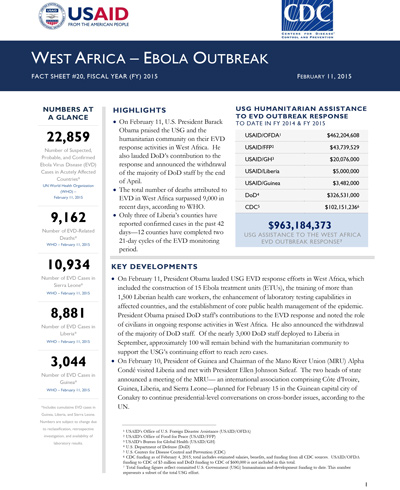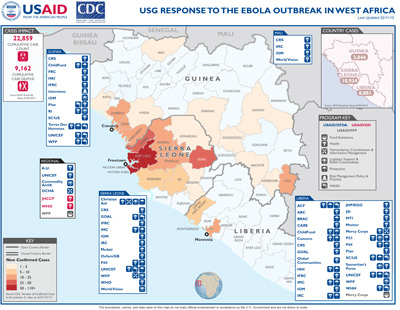February 11, 2015
HIGHLIGHTS
Ebola Response
Visit our main West Africa Ebola Outbreak page to learn more about how we're responding to the West Africa Ebola outbreak, and what you can do to help.
- On February 11, U.S. President Barack Obama praised the USG and the humanitarian community on their EVD response activities in West Africa. He also lauded DoD’s contribution to the response and announced the withdrawal of the majority of DoD staff by the end of April.
- The total number of deaths attributed to EVD in West Africa surpassed 9,000 in recent days, according to WHO.
- Only three of Liberia’s counties have reported confirmed cases in the past 42 days—12 counties have completed two 21-day cycles of the EVD monitoring period.
West Africa - Ebola Outbreak Fact Sheet #20 (FY 15) ![]() (pdf - 317k)
(pdf - 317k)
KEY DEVELOPMENTS
- On February 11, President Obama lauded USG EVD response efforts in West Africa, which included the construction of 15 Ebola treatment units (ETUs), the training of more than 1,500 Liberian health care workers, the enhancement of laboratory testing capabilities in affected countries, and the establishment of core public health management of the epidemic. President Obama praised DoD staff’s contributions to the EVD response and noted the role of civilians in ongoing response activities in West Africa. He also announced the withdrawal of the majority of DoD staff. Of the nearly 3,000 DoD staff deployed to Liberia in September, approximately 100 will remain behind with the humanitarian community to support the USG’s continuing effort to reach zero cases.
- On February 10, President of Guinea and Chairman of the Mano River Union (MRU) Alpha Condé visited Liberia and met with President Ellen Johnson Sirleaf. The two heads of state announced a meeting of the MRU— an international association comprising Côte d’Ivoire, Guinea, Liberia, and Sierra Leone—planned for February 15 in the Guinean capital city of Conakry to continue presidential-level conversations on cross-border issues, according to the UN.
CURRENT SITUATION
For the second consecutive week, total weekly case incidence increased across West Africa, with 144 newly confirmed cases recorded between February 1 and 8, according to WHO. While Liberia continues to report less than one case per day on average, Guinea and Sierra Leone documented 65 and 76 newly confirmed cases in the reporting period, respectively.
Community resistance to EVD response efforts continues in Guinea and Sierra Leone. The UN reported security incidents or community refusal to cooperate with EVD response activities in 10 of Guinea’s 34 prefectures during the final week of January. Three districts in Sierra Leone also reported at least one incident of resistance to EVD response efforts in late January.
The Guinean Ministry of Education reports that approximately 99 percent of schools have reopened, with only 70 schools still closed, according to the UN. The majority of the closed schools are in Faranah and Forécariah prefectures, where the UN reports community resistance to using school hygiene kits. In Sierra Leone, the government is planning to open schools in late March—currently, nearly 1.8 million children are out of school. In early February, the Ministry of Education, Science, and Technology and the Freetown Teacher’s College completed courses for master trainers on EVD prevention, social mobilization, and psychosocial support ahead of planned school openings.
West Africa Ebola Map #1 February 11, 2015 ![]() (pdf - 787k)
(pdf - 787k)
Liberia
Between February 2 and 8, the Government of Liberia reported 135 new suspect and probable cases across the country, with only three newly confirmed cases—all from Montserrado County. As of February 9, only three counties had documented a confirmed case during the previous 42 days, marking the passage of two 21-day monitoring periods without a confirmed case—WHO’s benchmark for declaring an area EVD-free—in 12 of Liberia’s 15 counties.
USAID/OFDA partners Mercy Corps and Population Services International (PSI) have trained more than 900 community mobilizers through the Ebola Community Action Platform (E-CAP) program. E-CAP supports the national social mobilization strategy, promoting behavioral change and providing health messaging. During the week of January 26, PSI staff trained an additional 72 community members to help improve EVD awareness and strengthen community engagement. At the request of the Ministry of Health, Mercy Corps and PSI have extended community mobilization trainings to border areas, which are vulnerable to possible infection, given that transient populations continue to cross unmonitored border points. Mercy Corps and PSI recently trained 53 mobilizers in Nimba County’s Ganta town—located near the Guinean border—to bolster EVD awareness.
The third cohort of USPHS Commissioned Corps officers arrived in Liberia February 4. Comprising 66 officers, Team Three will staff the Monrovia Medical Unit (MMU)—a specialized USG health facility for treating EVD response personnel who develop EVD symptoms. The outgoing Corps team provided handover and officially transferred command of the MMU to Team Three on February 7 before departing Liberia on February 8.
During the week of February 2, staff from the USG Disaster Assistance Response Team (DART) visited ETUs—operated by USAID/OFDA partner International Medical Corps (IMC)—in Bong and Margibi counties. According to IMC, the Bong ETU triaged 446 patients—including 160 who were EVD positive—between September 15 and February 8. The ETU in Margibi had triaged 167 patients between November 22 and February 8, four of whom tested positive for EVD.
Sierra Leone
During the week of January 26, the Port Loko District Ebola Response Center (DERC) reported 36 confirmed EVD cases for the district, a marked increase compared to the 10 cases reported from the previous week. The cases in Port Loko are largely responsible for the recent plateau in a previously declining EVD trend—the cases are originating from Lokomasama and Kaffu Bullom chiefdoms, according to an investigation by the Government of Sierra Leone (GoSL), CDC, and WHO. The main cause of recent transmission is a small number of unsafe burials, WHO reports.
With USAID/OFDA support, International Organization for Migration (IOM) is conducting social mobilization activities in Port Loko to promote EVD awareness and safe practices. Despite ongoing challenges in the district, WHO reports that EVD response efforts in Port Loko have improved since January 1. The Port Loko DERC reported that 50 percent of new cases during the week of January 26 were on contact lists—representing an improvement in data quality from previous weeks when Port Loko lacked sufficient data to report a figure.
On February 11, CDC—in collaboration with GoSL, the UK’s Department for International Development (DFID), and UN representatives—held a three-hour EVD awareness training for 50 members of the Sierra Leone Association of Journalists, including local journalists and editors. The primary objective of the training, which focused on reducing stigma and clarifying the risk of sexually transmitting EVD, is to improve the accuracy of EVD messaging in Sierra Leone’s national media.
Guinea
Health actors are expanding clinical trials of Favipiravir—an influenza pharmaceutical from Japan used to treat EVD patients in Europe—in Guinea, according to Guinea’s Coordination Cell. The Institut national de la santé et de la recherche médicale (INSERM), a French medical research institute, began conducting Favipiravir trials in December at an ETU in Guéckédou Prefecture. Although preliminary results of the study have not yet been released, initial findings suggest that the drug has accelerated recovery among adults and teenagers with low-to-moderate EVD blood levels, according to international media. The Government of Guinea (GoG) will allow health care workers to administer the experimental drug at ETUs in N’Zérékoré and Coyah prefectures.
USAID/OFDA partner Internews continues to disseminate EVD-related messages to the public. The organization launched its first 20-minute radio program on EVD-related information in Guinea on January 19. During 10 separate broadcasts in January, Internews talk show hosts covered a wide range of topics, including ETUs, GoG EVD-prevention efforts, community reticence, safe burials, and patient care. To date, the program has had more than 180 on-air speakers, including approximately 60 women guests. To expand outreach, particularly among youth, Internews is planning to launch a Facebook page for its program in Guinea in the coming weeks.
FOOD SECURITY AND LIVELIHOODS
USAID/FFP partner the UN World Food Program (WFP) continues to provide food assistance and nutritional support to patients receiving care at ETU facilities, discharged survivors, quarantined households, and areas with clusters of cases in Sierra Leone. In January, WFP provided assistance for more than 274,000 beneficiaries in Sierra Leone.
PUBLIC DONATION INFORMATION
- The most effective way people can assist relief efforts is by making cash contributions to humanitarian organizations that are conducting relief operations. A list of humanitarian organizations that are accepting cash donations for disaster responses around the world can be found at www.interaction.org.
- USAID encourages cash donations because they allow aid professionals to procure the exact items needed (often in the affected region); reduce the burden on scarce resources (such as transportation routes, staff time, and warehouse space); can be transferred very quickly and without transportation costs; support the economy of the disaster-stricken region; and ensure culturally, dietary, and environmentally appropriate assistance.
More information can be found at:
- The Center for International Disaster Information: www.cidi.org or +1.202.821.1999.
- Information on relief activities of the humanitarian community can be found at www.reliefweb.int.
USAID/OFDA bulletins appear on the USAID website at what-we-









Comment
Make a general inquiry or suggest an improvement.